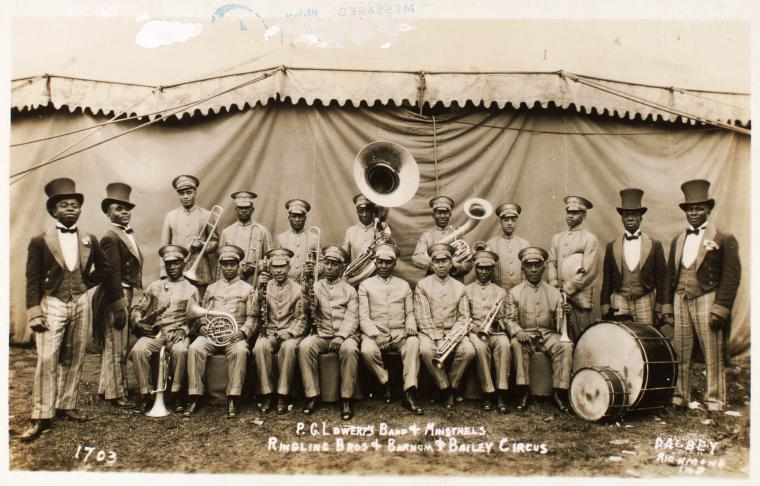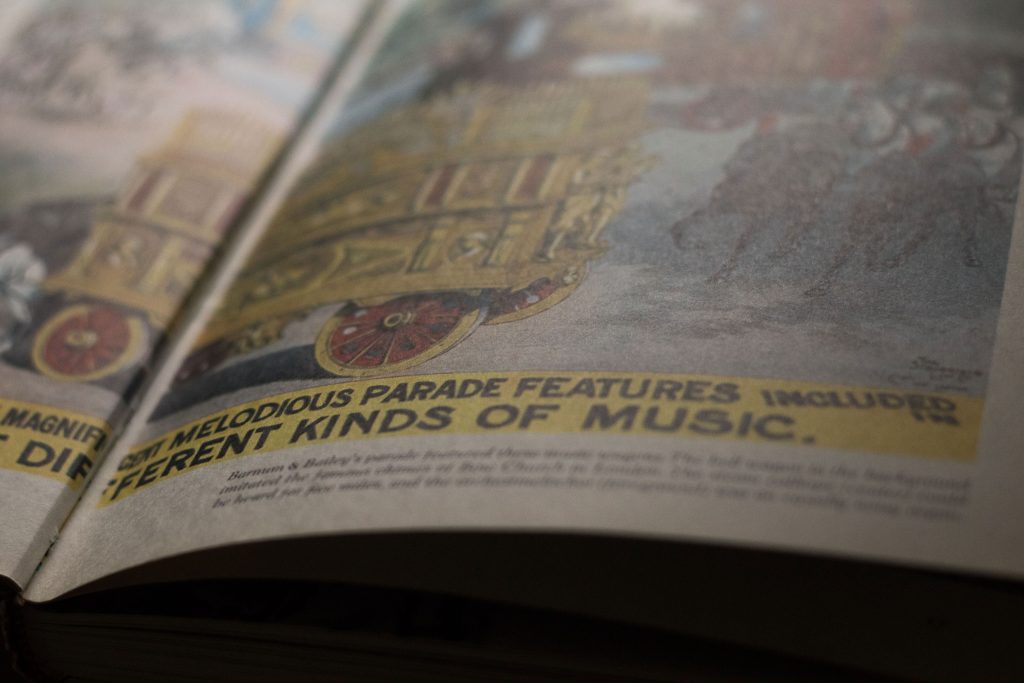Have a drink with: P.G. Lowery
The best under canvas.
Ask him about: Hustle.
If I say the words “circus music,” you probably have a certain type of music in your mind straight away – something loud, fast and slightly drunk – like this 1902 Sousa band recording of a typical “galop.” And that’s certainly on point, but it doesn’t clue you in to the fact that during the early 20th century, while largely white bands played under the big top, some of the most exciting circus music was happening over in the sideshow, where bands made up of black musicians not only played fast marches and brassy trombone “smears,” but innovated in ragtime, jazz and blues years before they would come into full public popularity. And perhaps the most impressive figure in these groups was the bandleader P.G. Lowery, a classically-trained cornet player who boiled down his many successes into a simple motto: “Good things cometh to he who waiteth as long as he hustleth while he waiteth.”
Perry George Lowery was born in 1869, to formerly enslaved parents who settled in Kansas after the Civil War. The Lowerys were a musical family, and formed a community brass band while working to establish and enlarge their land claim. A talented musician from childhood, P.G. claimed to have been largely self-taught – having left school to work on the farm, he found an old cornet in the attic and practiced in the barn whenever he could. He worked his way into local bands and competitions, and in 1895 enrolled in the Boston Conservatory of Music, where he was its first African-American graduate. For the first quarter of the 20th century, the circus was a reliable source of work for black musicians, who made up the majority of “sideshow bands,” and Lowery settled on the circus as a primary source of work.
Despite criticism of the circus as low-class industry, Lowery emphasized its opportunity for African-American musicians: “It is generally understood by the public at large,” he said, “that circus people have a tough time. I deny the assertion and will say for good treatment, equal justice and sure salary, give me the circus.”
A gifted businessman as well as a musician, Lowery advocated for other black performers and employees: training leaders and musicians, creating opportunities for talented black performers, and improving overall labor conditions at the circus, going so far as to lead a 1915 strike on the Hagenbeck-Wallace show in protest of wage and benefit cuts for black staff members. Historian Sakina Hughes notes that he “protested the demeaning messages of the minstrel show with his own touring show called, ’This is Not a Minstrel Show,’ and formed a labor union for black showmen to help ensure that wages, living conditions and benefits were up to standard.”
Lowery was renowned for the quality of his band and the ability to teach others in a certain style and quality of performance, making others recognizable as being from the “Lowery school.” A report in the Indianapolis Freeman in 1913 noted that each member of the band was always “striving hard to be able to add credit to the world-wide reputation of Mr. Lowery as a bandmaster, and to be able to play with credit in any band in the United States, as P.G. always freely shares his schooling, which he paid very dearly for in Boston.”

That said, it was not a free and easy path. Lowery succeeded in obtaining a dedicated train car for his musicians on the road, but but that was less a prestige move than a necessity, traveling amongst segregation and prejudice. Sideshow bands were still secondary to the white main-tent ensembles. And there was a lot of dog-whistle journalism around Lowery’s ability and race, despite the fact that all evidence points to the fact that the “best under canvas” label was not an exaggeration (one concert review notes that Lowery captivated the crowd by holding a note for sixty seconds). One Kansas newspaper claimed: “…if it was not for his color [Lowery] would probably be looked upon as the peer of any living cornetist.”
Lowery maintained forward momentum as a matter of principle. “I attribute the success of my band to private training,” he wrote. “All band masters [should] know the possibilities of each member of his band and select music within the limit of their ability. In conclusion as we are about to take one more step from the old year to the new let us start with renewed vigor; let us march hand in hand and throw off all appearance of malice and back-biting and as we reach the top we must work hard to hold our place. We must constantly produce something new to attract the attention of those below us.”
Hard work paid off: having toured and played with his own ensembles and many of the major circuses, in 1920 P.G. Lowery brought his band to Madison Square Garden for the opening of the Ringling Brothers and Barnum & Bailey show’s New York run, where they were the first black band to play for the main show.
Fun Facts:
Biographer Clifford Watkins suggests that Lowery’s path to the Boston Conservatory was paved by competition winnings – he believes that the prize in an 1894 prize competition at the Hutchinson, Kansas Musical Jubilee may have been scholarship funds.
Ragtime was growing in popularity during the late 19th and early 20th century period during which Lowery’s bands were entertaining circus audiences, and Scott Joplin was among those who sang Lowery’s praises: the composer dedicated his 1902 piece “A Breeze From Alabama” to Lowery.
Circus bands were versatile and hardworking, with those in the biz referring to musicians as “windjammers” for the amount of air they pushed through horns for hours and hours on end. In any circus, musicians were an indispensable part of the show: bands entertained passing customers and accompanied barkers shouting their pitch – or “bally” – out on the sideshow and the midway; played in parades and concerts; and in a tent, musicians would set tempo, punctuate action (not unlike a movie score), provide sound effects, whip up emotion or patriotism, and even signal staff if something wasn’t right. Circus musicians had to be skilled, nimble, resilient and – yes – able to jump on the bandwagon.
Want to know what these bands looked like? There are beautiful images out there – like this one of the (all-white) 1910 Ringling Brothers band, and another of the Lowery sideshow group. For a summary look at P.G. Lowery and his impact on circus and music, check out this PBS video:
Additional Reading:
Sakina Hughes, “Under One Big Tent: Race, Resistance and Community Building in Two Nineteenth-Century Circus Towns,” in Beyond Two Worlds: Critical Conversations on Language and Power in Native North America (2014)
Clifford Edward Watkins, Showman: The Life and Music of Perry George Lowery (2003)
Leon Botstein, “Circus Music in America,” in The American Circus (2012)
